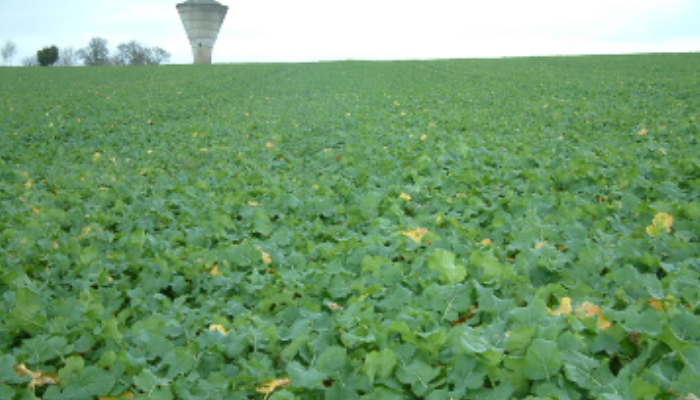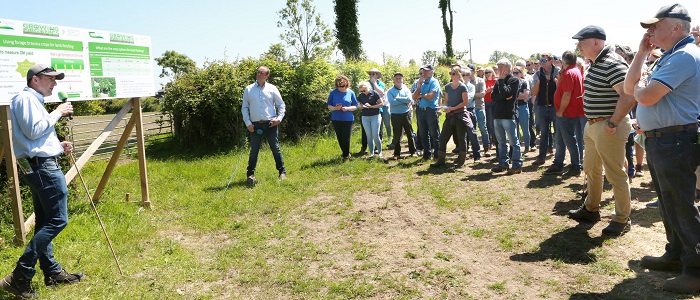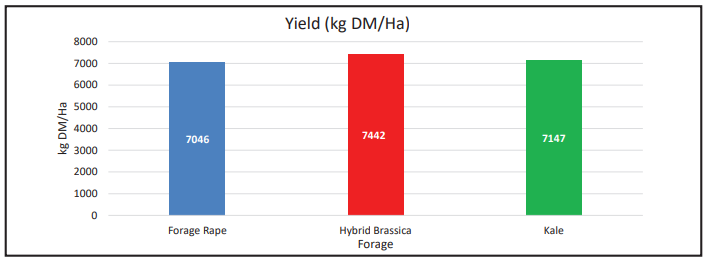12 June 2023
Management key to maximise lamb performance from brassica crops

Research work carried out in Teagasc Athenry has examined ways to get maximum utilisation and performance from winter grazed brassica crops.
As part of the recent Growing Organics farm walk on Jason Stanley’s farm in Co. Laois, Dr. Frank Campion, Teagasc Research Officer, offered advice and guidance to farmers who may be sowing crops of forage rape, hybrid brassica or kale later this year.
The first step in maximising yield from these crops when grown as forage for finishing lambs is to sow at the correct time, with yields declining after an early-August establishment.
“When people sow later, their yield is very poor and your yield is going to drive what you are going to do with it. With lambs, you would want to allow 1.8kg DM/lamb/day. With forage crops, it is vitally important that you are measuring yield. Like grass or any other crop, the yield and quality of the crop will influence the amount of lambs you could potentially finish,” Dr. Campion explained.
By knowing the yield of the crop through cutting and weighing, using a 1m2 quadrant, the number of grazing days and the lamb carrying capacity of the crop can be established. Preference is to stock the crop at a rate that will carry lambs the entire way through to finish. Lamb intake for this calculation should be based on 3% of body weight.
“You have to look at how much finishing the lambs require and how much crop you have available. In the past, we have seen hill lambs gaining 120g/day on brassica crops. Lowland lambs are probably gaining 180g/day, particularly in the summer months. If lambs are gaining 180g/day, you are looking at about one month to put on 5kg on that lamb, as there is an adaption period as well. If you are going in with a lot of light lambs, you need a lot to keep them on the crop and to try and finish them on it,” he explained.

Frank Campion and Jason Stanley addressing crowds at the Growing Organics farm walk
Introducing lambs to brassica crops
Lambs need to be introduced to forage brassicas gradually with a run back to grass up until the point of full-time access. This occurs approximately 10 days after first access. Once lambs have acclimatised to the diet and are full time on the crop, they require ad-libitum access to a fibre source such as silage, hay or straw.
Any of these sources will do and although intakes will be low, it is still essential to provide it, he explained. Forage brassicas, particularly the leaf component, can be very digestible and lower the rumen pH, as you would experience if feeding ad-libitum concentrates. Therefore, providing a roughage source ensures that even at this lower pH, the rumen continues to function correctly.
Crop management
In the studies carried out by Teagasc, lambs received two-day allocations of forage brassica to try to maximise the utilisation of the crop and the performance of the lambs. While this length of time can vary, it is important that lambs are not left grazing the one area for too long.
The key principle behind this is that the lambs will selectively graze the leaves of the crops first, followed by the soft stem and eventually the harder stem. The highest nutritional benefit to the lamb comes from the leaf.
By moving the lambs regularly, they are getting access to the leaf of the plant every two days and only having to graze the harder and lower nutritional value parts for shorter periods. It is still important that lambs be allowed to graze some of the stem, which will improve utilisation, but also ensure they are getting a balance of fibre from the plant. However, care is needed when allocating the crop area that they are not left too long grazing a certain area and are short on forage.
Utilisation
The research work from Teagasc Athenry indicated that lambs grazing forage rape and hybrid brassica utilised 58% and 62% of the crop respectively, while the kale was more difficult to utilise. Due to its thicker stem, utilisation rates of 53% were recorded. Kale contains a higher level of stem compared to forage rape and hybrid brassica, which makes it more difficult for lambs to graze (table 1).
Table 1: Effect of forage type on pre-grazing leaf and stem content
| Total utilisation (%) | Leaf (%) | Leaf utilisation (%) | Stem (%) | Stem utilisation (%) | |
|---|---|---|---|---|---|
| Forage rape | 58 | 46 | 86 | 53 | 37 |
| Hybrid brassica | 62 | 47 | 76 | 53 | 56 |
| Kale | 53 | 37 | 58 | 63 | 45 |
Commenting on these utilisation rates, Dr. Campion said: “The key message we found was that you really have to pick your crop to suit your system. For lambs grazing on kale – particularly when you get into high yields – it is very hard to achieve high utilisation. You have too much stem and the lamb isn’t able to graze on it the same was a cows or cattle would.
“With finishing lambs, we found that we are getting the best utilisation from forage rape and hybrid brassica and that is driven by the leaf to stem ratio. If you look at our forage rape and our hybrid brassica, nearly 60% of the plant is leaf and that’s what we want – that’s the most nutritious part. With the kale, once we get into the high level of yield, we are finding that the leaves tend to drop down so it is not really suited to a lamb finishing system.”
Furthermore, he said: “The other advantage of the forage rape and hybrid brassica is they are relatively short growing. Within 60-90 days you are grazing, whereas kale takes a bit longer and has to be sown earlier in the year and the field is out of action for a bit longer.”
Lamb performance and crop yield
The studies have shown no significant different in lamb growth rates between lambs grazing forage rape and hybrid brassica and Kale. There was also no difference in carcass weight or kill out percentage between lambs from each of the forage brassica treatments. Average kill out percentage was 45%. In terms of performance for the crops (grown under non-organic commercial conditions) all three crops grew similar levels of dry matter/ha (Figure 1).
Figure 1: Effect of forage type on pre-grazing yield (kg DM/ha)

Also read: Pay head to grass and clover varieties when choosing multispecies swards
The open day booklet from Jason Stanley’s farm walk is available here.
